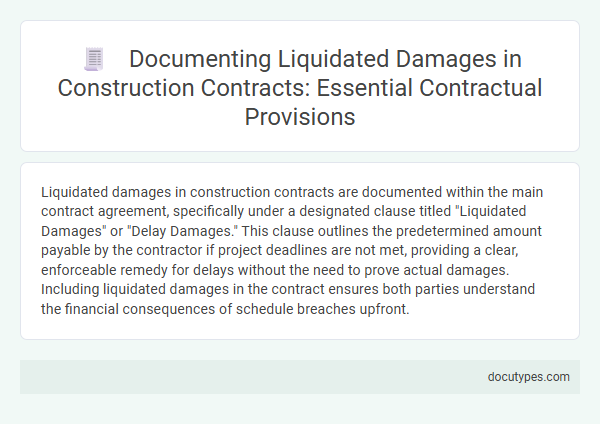Liquidated damages in construction contracts are documented within the main contract agreement, specifically under a designated clause titled "Liquidated Damages" or "Delay Damages." This clause outlines the predetermined amount payable by the contractor if project deadlines are not met, providing a clear, enforceable remedy for delays without the need to prove actual damages. Including liquidated damages in the contract ensures both parties understand the financial consequences of schedule breaches upfront.
Introduction to Liquidated Damages in Construction Contracts
Liquidated damages in construction contracts are typically documented in the contract agreement itself, often under a dedicated clause titled "Liquidated Damages." This clause specifies the pre-agreed amount payable if the contractor fails to complete the project on time or meets other specified conditions. Understanding where liquidated damages are documented helps you manage risks and ensure compliance throughout the construction process.
Legal Foundations of Liquidated Damages Clauses
What type of document documents liquidated damages in construction contracts? Liquidated damages clauses are typically included in the construction contract itself, often within the general conditions or special provisions. These clauses establish predetermined compensation amounts for delays or breaches, providing clear legal foundations to enforce damages without requiring proof of actual loss.
Key Elements of a Valid Liquidated Damages Provision
In construction contracts, liquidated damages are documented within the contract agreement to define pre-agreed compensation for delays or breaches. A valid liquidated damages provision ensures clear terms that protect both parties from disputes.
- Defined Liquidated Damages Clause - Specifies the exact amount or formula for calculating damages due to delay or non-performance.
- Reasonable Pre-Estimation - Reflects a genuine pre-estimate of potential losses rather than a penalty imposed on the contractor.
- Clear Triggering Events - Lists specific conditions or breaches that activate the liquidated damages provision.
Drafting Clear Trigger Events for Damages
In construction contracts, liquidated damages are documented within the main contract agreement or a dedicated clause specifically addressing damages. Drafting clear trigger events is essential to define the circumstances under which liquidated damages apply, ensuring enforceability and minimizing disputes. Precise language outlining delay events, performance failures, or breach conditions creates transparency and protects the interests of all parties involved.
Establishing Reasonable Damages Amounts
Liquidated damages in construction contracts are typically documented within the contract agreement itself, specifying predefined damage amounts for delays or breaches. Establishing reasonable damages amounts ensures that the liquidated damages are enforceable and reflect genuine pre-estimates of loss.
- Contract Agreement - The primary document outlining liquidated damages terms, defining the conditions and amounts applicable.
- Schedule of Values - Sometimes included to correlate costs and timelines, supporting the calculation of liquidated damages.
- Clause on Delay Penalties - A specific section that details the assessment and application of liquidated damages in case of project delays.
You should ensure the damages amount is reasonable to avoid disputes over enforceability and compliance with legal standards.
Notice and Certification Requirements
| Document Type | Description | Notice Requirements | Certification Requirements |
|---|---|---|---|
| Construction Contract | Primary agreement outlining terms, conditions, scope, and liquidated damages provisions in construction projects. | Specifies the timeframe and method for issuing notice of liquidated damages claims, often requiring written notification within a set number of days after the delay or breach occurs. | May require certifications from the project manager or contractor verifying delay impacts and entitlement to liquidated damages before enforcement. |
| Claims Notification Document | Formal notice submitted by contractor or owner to initiate claim for liquidated damages based on contract stipulations. | Must comply with contract-mandated deadlines and include detailed description of delays or damages triggering liquidated damages. | Certification of accuracy and validity of claim details often required to support contractual enforcement. |
| Liquidated Damages Certification | Official document certifying the calculation and applicability of liquidated damages under contract terms. | Notices for certification generally outlined in the contract, requiring timely submission. | Certification typically includes affirmation by authorized personnel confirming damages and contract adherence. |
| Project Closeout Documentation | Final compilation of all contractual obligations fulfillment, including settlement of liquidated damages. | Includes final notices regarding any liquidated damages assessed before project completion. | Final certification documents confirm satisfaction or deduction of liquidated damages per contract. |
Mitigation and Prevention Provisions
The type of document that typically documents liquidated damages in construction contracts is the contract agreement itself. It outlines specific clauses related to delay penalties and compensation mechanisms agreed upon by both parties.
Mitigation and prevention provisions within the contract emphasize proactive steps to avoid delays and minimize damages. These clauses require contractors to implement strategies such as effective scheduling, resource allocation, and timely communication to reduce the risk and impact of liquidated damages.
Enforceability and Common Legal Pitfalls
Liquidated damages in construction contracts are documented primarily in the contract agreement. Enforceability hinges on clear, reasonable terms to avoid common legal pitfalls.
- Contract Agreement - This primary document specifies liquidated damages clauses including amounts and triggers.
- Reasonableness of Damages - Courts enforce liquidated damages only if amounts represent a genuine pre-estimate of loss, preventing penalties.
- Clear Language - Ambiguous or vague liquidated damages provisions risk being invalidated due to lack of certainty.
Integration with Delay and Extension Clauses
The type of document that typically documents liquidated damages in construction contracts is the contract agreement or the main construction contract. This document outlines the predetermined compensation payable by the contractor if project delays occur, ensuring clear financial accountability.
Liquidated damages clauses are often integrated with delay and extension clauses within the contract to manage project timelines effectively. Delay clauses specify circumstances under which the contractor may request extensions, while extension clauses provide the process for such requests. This integration balances contractor protection against unjust penalties with the owner's right to timely project completion.
What Type of Document Documents Liquidated Damages in Construction Contracts? Infographic

